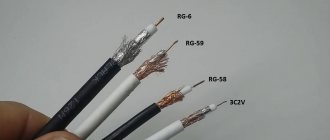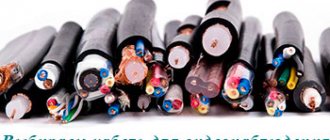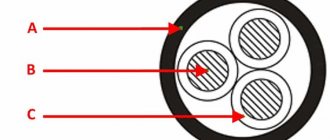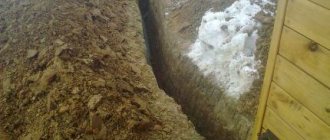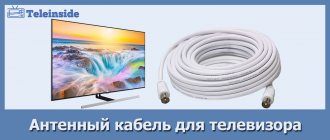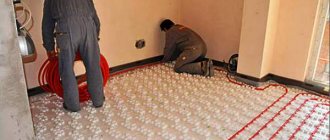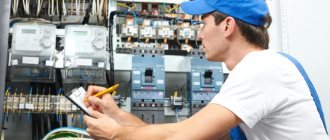Diameter or cross-sectional area
There is one important point that not everyone is aware of. In the description of the “twisted pair” cable (aka UTP, FTP or F/UTP) and on its packaging it is usually written 4x2x0.51 (sometimes 4x2x0.52). This means that there are 4 twisted pairs in the cable, 2 cores per pair, the diameter of each core is 0.51mm. Diameter, not section!
On power cables (VVG or NYM or KGVV or MKSh) the cross-section is always written, measured in square millimeters, for example, 3x1.5, 5x4 or 2x0.75. And we already have in our heads the typical maximum currents that can flow through such cables, for example, through a cable with a cross-section of 1.5 - 10 amperes, 2.5 - 16 amperes. And it seems that since the twisted pair has a cross-section of 0.51 mm2, then it will withstand a couple of amperes.
But no! Historically, twisted pair cables are designated not by cross-sectional area, but by diameter, because of this, of course, wild confusion arises.
Many sites have written to us with an error that for a twisted pair cable the value 0.5-0.6 refers specifically to the cross-section, and not to the diameter.
2.10. Twisted pair cable
Twisted pair cables are widely available, inexpensive, and easy to install.
There are two types of them: • shielded (STP);
• unshielded (UTP).
Through twisted pair, you can transfer data at an acceptable speed - in some local networks up to 1 Gbit/s. A number of companies are developing shielded cables for 10 Gbps. Unshielded telephone voice cables are more common than high-quality LAN data cables.
In twisted pair, two conductive strands are twisted around each other. The signal is transmitted as a voltage difference between two conductors. In each conductor of the circuit, current flows in the opposite direction, as shown in Fig. 2.20.
Rice. 2.20. Current in twisted pair cable
Since this current is the same and flows in opposite directions, the magnetic field of the two wires mutually compensate each other, and inductive interference from external sources is also compensated. Therefore, this type of cable shields itself and is less susceptible to external influences.
Twisting the wires minimizes interference between pairs. Pairs help cope with electromagnetic (EMI) and radio frequency (RFI) interference, as well as balance mutual capacitance. The performance of a twisted pair cable can be improved by increasing the number of turns per meter in the twist. Each pair in a 2-pair cable contains a different number of turns to reduce mutual interference.
Figure 2.21. Shielding magnetic fields in twisted pair cables
2.10.1. Twisted Pair Cable Components
A twisted pair cable consists of the following components.
Conductive cores
The signal wires in this cable are made up of pairs twisted around each other. Typically the conductive wires are made of copper. They can be solid (from one wire) or twisted (from many thin wires closely adjacent to each other). The cable usually contains several twisted pairs: usually 2, 4, 6, 8, 25, 50 or 100 pairs in a bundle. For local networks, cables with two and four pairs are most often used.
Screen
In a shielded twisted pair (STP) cable, each pair of conductors is wrapped in a foil shield.
Shell
The bundles of wires are encased in a sheath of polyvinyl chloride (PVC) or, in filled cables, a fire-resistant material such as Teflon or Knar.
There are two main types of twisted pair cable: shielded (STP) and unshielded (UTP). The shielded cable contains an additional protective shield around each pair to reduce the influence of external interference. This additional protection makes shielded cable more expensive than unshielded cable. (The price of thin coaxial cable is usually between the prices of shielded and unshielded twisted pair cables.)
What is AWG
Since we're talking about this, you can see the letters AWG on twisted pair cables. This is an American standard describing the diameter of a cable. Moreover, the larger the number written after the letters AWG, the thinner the cable. Here's a simple sign:
In the same plate you can see the relationship between the diameter of the cable core and its cross-sectional area. If desired, the same numbers can be obtained using the formula S = pi * R^2 (section = 3.14 * radius squared). Remember that the radius is only half the diameter.
The most common cable is AWG 24, the diameter of each twisted pair core is 0.51 mm, and the cross-sectional area is only 0.204 mm2.
It turns out that the cross-section of the twisted pair core is extremely small, and the current that can be transmitted through it is also extremely small. In the case of low-current power supply, it is necessary to look not for the maximum current that can be transmitted over a twisted pair so that it does not melt, but for the voltage drop in it. That is, you need to know the cable length, load current and resistivity, then, according to Ohm’s law, calculate the voltage drop in the cable in order to obtain the voltage that will arrive at the powered device passing through the cable. I considered these calculations when I wrote about powering LED strips.
Bus cables
If we have a CAN or RS485 or KNX bus spread throughout the premises, and devices that are powered by it hang on the bus, then we need to carefully consider the choice of cable for the bus. If we connect a dozen Wirenboard sensors to one bus up to 60-70 meters long, then there will be no problems, since the current consumption is small and the line length is short. If we transfer the bus to some kind of intermediate shield in which the modules are located, then it is better to install a separate power supply in this shield for reliability. Well, in the general case, you can use something thicker rather than twisted pair for power transmission. For example, KPSVEV 2x2x0.75 has a fair cross-sectional area of each core of exactly 0.75mm2, that is, 3.7 times more than a twisted pair. Accordingly, the voltage drop is 3.7 times less. But the cable is also much thicker. And there were fewer spare veins.
Special interface cables for RS485 usually also have a small cross-section; their core diameter is usually about 0.6-0.8 mm. They are not designed to supply a large number of consumers on a bus.
Special cables for the KNX bus usually have a diameter of 0.8 mm.
For KNX devices, it should be noted that the current consumption is extremely small, a few microamps. Some devices require a separate 24 volt power supply, for example, large touch panels; power can be supplied to them using a separate 2x0.75 cable.
Don't buy cheap twisted pair cable
I warn all clients - do not buy cheap twisted pair cable! It’s very cheap - it’s less than 10-12 rubles per meter. The very cheap ones say CCA, which means that the cores are not made entirely of copper, but copper-plated. The copper one says CU (cuprum!).
Next we look at the diameter. 0.46 is undesirable, 0.51 is desirable. It seems that the difference is small, but it affects the quality of the cable.
What is a low-quality cable? This is the kind that you plug into a switch and the wire breaks. Moreover, at the very exit of the vein from the wall, that is, this vein no longer exists. This is the most unpleasant situation. It is recommended to use cables from such manufacturers as Lapp, Hyperline, Legrand, Cavel. Even if the cable turns out to be expensive (50 rubles per meter), but in critical construction sites problems may arise due to low-quality cable, the cost of solving which will be much higher than the cost of the cable.
If it is possible to buy a cable in a coil of not 305 meters (again, the American standard is 100 feet), but 500 or 1000 meters, then there will be less scraps.
There is no need to use a category 6 or even 7 cable to transmit signals (unless you need a 10-gigabit network); a higher category does not automatically mean higher quality. A category 6 cable is more rigid than a category 5 cable and is less convenient to install into a low-current cabinet. If category 6 computer network cables are inserted into a switch in a low-current cabinet without a patch panel, then it will be very difficult to bend them so that they go into the switch and allow the cabinet lid to close.
21, total, today
Related posts:
- Selection of Wirenboard equipment and system design I’ll tell you a little about how to design a Smart Home system on…
- Cable installation for a Smart Home As I already wrote, the most unreasonable way to save money in construction...
- Connecting powerful LED strips There are a lot of subtleties in connecting LED strips. That's just a huge amount...
- Cables for LED strips LED strips have already become an integral part of the interior. They allow you to create...
- RS-485 Modbus in Smart Home systems Modbus in Smart Home systems In wired automation systems Smart…
- Dimming lighting from a Smart Home Let’s touch on the topical issue of dimming lamps from the Smart Home system, especially...
- Terminal blocks for low-current cables Everyone decides which terminal blocks to install for low-current cables...
Which one is better to choose?
Which cable to choose for a video surveillance system?
Typically, choosing the right type of CCTV cable depends on your specific situation, your desires and the cameras you choose. In the case of IP cameras, this is almost always the unambiguous use of a UTP cable with RJ-45 connectors; analogue video surveillance with a small number of cameras can get by with a regular coaxial cable at distances not exceeding 100-300 meters, and to be able to supply power and transmit signals over one cable it is necessary use either a combined video surveillance cable with power or twisted pair cable. If you have a large number of cameras and longer distances, we would recommend using a twisted pair cable - UTP, FTP or STP cable - depending on the distances, location of use (outdoors, indoors) and sources of interference.
The differences in the location of communications will be that for external cameras it is necessary to use a cable with protective external insulation made of solid polyethylene, and for internal video surveillance systems it can be taken from ordinary PVC. Also, a cable for outdoor installation may have a steel support cable in its design, which is necessary to enhance the strength of the cable when laying the cable through the air (KVK-Pt).
In this article, we tried to analyze as much as possible the question of how to choose the right cable for video surveillance, talked about the main types and their characteristics, tried to highlight in as much detail as possible those design differences that play a major role in choosing the most suitable cable depending on a particular CCTV systems and your preferences. We wish you good luck and hope that this material remains useful to you!
With this they read:
CCTV camera lens viewing angle
Dummy CCTV camera
Night CCTV camera
Analogue CCTV cameras vs IP: what to choose?
Did you like the article? Share with friends on social networks!
- Ilya
04/14/2017 at 12:09good afternoon!!! The distance to the cameras is 160 meters!!! what cable should I use? did you want a regular home twisted pair cable or is it too far?
Reply ↓
Alexander Starchenko
(Post author)04/18/2018 at 05:25
Hello, Ilya. You can use a repeater every 80 meters, but AHD and TVI digital cameras would be better. They now have a resolution of up to 5 megapixels, a range of up to 500 meters.
- Anonymous
03/24/2019 at 03:25
there are laser cameras up to several kilometers
04/17/2017 at 12:21
you need cable RK-75-2-13—100 meters. Is it available and how much does it cost?
Reply ↓
- Alexander Starchenko
(Post author)04/18/2017 at 05:34
Hello, Sergey! The cost of this cable from various sellers ranges from 10 to 30 rubles/meter.
07/08/2017 at 17:02
Thanks informative!
Reply ↓
07/23/2017 at 12:44
hello, tell me how to connect the camera to the video intercom, the camera has 4 pairs of colors and there are two wires coming out of the video intercom
Reply ↓
- Alexander Starchenko
(Post author)08/05/2017 at 17:46
Hello. Not every video intercom can connect a video camera; read the instructions for the intercom.
08/07/2017 at 11:50
hello, please tell me, we connected the camera via UTP twisted pair cable, the distance is 10 meters, and the picture is rippling! But at night it doesn’t show!! The cameras were changed, the signal amplifiers were installed, everyone has already changed their minds, there is no electrical wire nearby, everything is connected clearly and perfectly, checked inside and out several times!!! Has anyone come across this?
Reply ↓
- Alexander Starchenko
(Post author)08/12/2017 at 12:31 pm
You need to check using the KVK or RK75 cable, if the ripples stop, then the problem is in the cable, and if not, then the camera needs to be returned under warranty
08/21/2018 at 14:20
Your symptoms hinted to me that the power supply unit. poor. There is a possibility that there is a power drawdown during the day, and at night due to the backlight there is a complete failure.
02/20/2020 at 06:43
If it doesn’t show at night, then there is a possibility that there is not enough current from the power source and when the LEDs are turned on, the camera falls off
01/03/2021 at 23:17
Check the operating temperature of the camera, we toiled for a whole week and it turned out that at night the temperature drops below minus 20 degrees and the camera stops working, this also happens, and about the power supply as a possible reason, make sure that it is in order, for cameras designed for 12 volts the operating range is from 11 .3 volts to 14 volts
08/26/2017 at 09:31
Good afternoon. And with what characteristics should you use a UTP cable when connecting IP cameras powered by PoE technology. The maximum distance to the cameras is 40 m.
Reply ↓
- Alexander Starchenko
(Post author)09/12/2017 at 10:30
Good afternoon. For 40 meters you can use any cable, the distance is not long.
10/18/2017 at 12:22
Hello, I need to connect 8 cameras on the street, the cameras will be on poles around the area, but I don’t know which cameras need to be taken so that I can use twisted pair, but twisted pair (with foil insulation) but RJ-45, is there such a thing? And how to connect everything into one circuit, hook up the adapters on the branches to the cameras? Thank you.
Reply ↓
- Alexander Starchenko
(Post author)10/26/2017 at 07:37
IP cameras are connected via twisted pair, RJ-45 is a universal connector used in UTP, FTP, STP cables.
10/25/2017 at 12:12
Good afternoon! Please tell me I have a cable for IP cameras. They burned out. Can I put analog cameras on these wires? Thank you in advance
Reply ↓
- Alexander Starchenko
(Post author)10/26/2017 at 07:40
Good afternoon, yes you can.
12/12/2017 at 11:35
Good day! Tell me, I have a combined cable with power supply of 10 meters, can I extend the cable with a simple antenna to the TV?
Reply ↓
- Alexander Starchenko
(Post author)12/13/2017 at 05:23
Hello. Yes you can, with a resistance of 75 ohms.
12/12/2017 at 22:15
Hello. I connected the HD-TVI camera to the DVR via twisted pair cable. Distance 10 meters. The signal does not pass through, the recorder does not see the camera. What can be wrong?
Reply ↓
- Alexander Starchenko
(Post author)12/13/2017 at 05:24
Hello, Vladimir. You need to use TVI converters for twisted pair, or connect with a coaxial cable.
03/11/2018 at 18:30
Hello, I have a camera with two tulip connectors (yellow and red) and a power connector, please tell me which cable is more suitable for connection. Distance 10 meters.
Reply ↓
- Alexander Starchenko
(Post author)04/18/2018 at 05:27
Hello Aram. A coaxial cable will suit you, maybe with a transition to BNC.
03/19/2018 at 11:40
Can you tell me how to crimp 2-pair UTP to connect a video recorder and a computer?
Reply ↓
- Alexander Starchenko
(Post author)04/18/2018 at 05:28
A DVR is like a computer. Accordingly, if directly, then a cross connection, if through a hub, then direct crimping.
04/05/2018 at 15:06
Hello, please tell me which of the 8 wires can be used to power IP cameras. There is no PoE, we just saw how 2 wires from UTP are separated and the power supply is simply connected.
Reply ↓
- Alexander Starchenko
(Post author)04/18/2018 at 05:28
Hello. The blue pair is entirely for minus power, the brown pair is for plus power. Direct crimping (hub-computer).
04/15/2018 at 18:03
Good evening, please tell me. 3ip cameras are connected to the switch. From the candle there is a loco transmitting point at a distance of 200 meters. We use UTP cable on the cable. What problems might arise? Will distance affect signal transmission?
Reply ↓
- Alexander Starchenko
(Post author)04/18/2018 at 05:25
Hello, Alexander. It is better to use a response point not loco, but a full-fledged one in bridge mode. And you need direct visibility. There should be no other problems, the scheme is working.
05/17/2018 at 22:13
Is it possible to run a KVK cable underground in a metal pipe at a distance of 70 meters?
Reply ↓
- Alexander Starchenko
(Post author)05/22/2018 at 10:15
It is possible, as long as the pipe is sealed. Usually HDPE pipe is used, it is without seams.
05/19/2018 at 07:45
Hello. I connected the KPC-EX190SHB1(H-Res) video camera. The camera shows well, but does not last long. The camera soon becomes very hot and wide black stripes appear in the video. The instructions say that it is important that the current is no more than 80mA.
Reply ↓
- Alexander Starchenko
(Post author)05/22/2018 at 10:14
Hello. In the early 2000s, there were cameras that operated only in pulse mode, based on a motion sensor; the same ones were used in video intercoms; they were a little cheaper. You either have a camera malfunction or a pulse camera. It is better to replace it with a more modern AHD.
05/19/2018 at 12:15
Good day, the problem is this: the object has been adjusted, 15 cameras need to be installed, but the cameras are used, the distance to the farthest camera is 300-350 meters, do I need to install amplifiers and at what distance
Reply ↓
- Alexander Starchenko
(Post author)05/22/2018 at 10:13
We tested it on AHD Space technology cameras, the cameras worked normally at a distance of 250-320 meters. These cameras are currently on sale in May and cost 850 rubles each! They have a resolution of 1 megapixel, naturally colored, with night illumination, outdoor, with a stated distance of up to 500 meters. It would be better to replace analog cameras with long-range ones.
05/23/2018 at 10:28
Good afternoon I bought 6 ST-1045 AHD cameras, I’m trying to connect via twisted pair, the signal doesn’t come to the recorder, I bought passive transceivers, it still doesn’t work. What can be wrong
Reply ↓
- Alexander Starchenko
(Post author)05.25.2018 at 07:24
Good afternoon. ST-1045 cameras are connected via coaxial cable: RK-75, KVK or similar. If you do not have the opportunity to use coaxial, then at your own peril and risk you can connect twisted pair cables through specialized transceivers for the AHD signal. Transceivers for analog signals are not suitable. And remember that this combination very strongly picks up any interference, for example from a 220V network. Therefore, place the twisted pair cable as far as possible from the source of interference (other cables). In addition, make sure that the recorder input is turned on in AHD mode
05/24/2018 at 13:40
Good afternoon Is it possible to use an SFTP cable to connect cameras by laying it in a pipe underground?
Reply ↓
- Alexander Starchenko
(Post author)05.25.2018 at 07:27
Good afternoon You can use a sealed pipe, for example HDPE.
05/25/2018 at 19:15
Good afternoon. There is a need to create a temporary video surveillance system at the site. 10 cameras. Distances from the recorder from 30m. up to 600m. The question is what is the best way to do it (cameras on poles, power will not be supplied to the poles).
Reply ↓
- Alexander Starchenko
(Post author)05/27/2018 at 09:24
Hello, Rinat. Clarify your question, what do you mean when you say “what is the best way to do it?” What cameras are you going to use - analogue or IP?
05/27/2018 at 16:38
Hello, is it possible to connect several cameras on one shielding wire and the central wire separately? Thank you.
Reply ↓
- Alexander Starchenko
(Post author)05/28/2018 at 05:24
What cameras are you going to connect? In general, the grounding conductor can be combined.
06/01/2018 at 23:40
Hello, we have an IP camera with a distance of 250m. The recorder does not see it, the cable rings and the power comes to the camera. The camera is registered and tested on a short cable. The switch produces three short signals with a pause and repeat. What should I do? Thank you in advance
Reply ↓
- Alexander Starchenko
(Post author)06/02/2018 at 06:09
IP cameras operate at a distance of 80-100 meters. At 250 you can use AHD cameras. If you want IP, then an option is repeaters every 80 meters or WiFi with line of sight.
06/19/2018 at 07:09
Hello, I have a building with 2 floors plus a roof with metal tiles, I’m going to install a total of 10 cameras inside and outside the building and one on the metal tiles, the question is which cable is better to take, just UTP and with braid, then on the floor for each camera I’m like this I understand that grounding needs to be done, I’m also going to install a passive poe injector with 16 ports to power these cameras, and then take one wire from the injector to the receiver, the distance to the cameras will be no more than 100m, thank you in advance
Reply ↓
- Alexander Starchenko
(Post author)06/30/2018 at 11:14
Hello. You have a wrong idea about the camera connection diagram. More than one wire will come from the injector. If you can provide an approximate diagram of the installation of cameras with marked places, we can make you a commercial offer. What does it mean that I plan to install a camera on a metal tile? Cameras are not installed on metal tiles; you will create a leak in the roof.
06/19/2018 at 23:08
Dear time of day! SNT, we want to install a video surveillance system at the beginning of 4 streets. From 30 to 200 meters to the registrar 0. The lines are supposed to be pulled along 0.4 kV power poles. Install the recorder next to/inside the PTS. It is advisable to turn on motion sensor cameras and at least one microphone. What are your recommendations for equipment? Thanks in advance for your answer
Reply ↓
- Alexander Starchenko
(Post author)06/20/2018 at 13:39
A total of 300 m of cable was laid. In your case, you can either save money by installing general-view cameras, or (which is preferable) install narrow-angle cameras to view each street in the distance. The latter, with a resolution of 2MP 12mm, will cover up to 30-40 meters in length. If we take similar ones with a focal length of 50mm, then their maximum operating range will be up to 200 meters.
But these cameras will no longer be able to see the 20 meters closest to the camera. Of course, such narrow-angle cameras are more expensive, 12,000-19,000 per unit. It is not advisable to install microphones outdoors; moisture condensation quickly damages them. Or are you planning indoors? If you are interested in equipment, call the phone number listed on the website.
08/02/2018 at 09:46
Hello. They gave me a regular analog camera, I installed and ran a regular military field wire twisted (black), the distance of 45 meters shows dimly and in the evening nothing at all, I installed the electrical power next to the camera. The image has not improved, please tell me what am I doing wrong and do I need to install the power supply nearby? Thank you in advance, I'm waiting for your answer.
Reply ↓
- Alexander Starchenko
(Post author)08/07/2018 at 12:48
Hello. It is better to use a KVK combined cable. A high-quality cable that allows you to transmit power up to 60 meters and a video signal up to 500 meters costs ~ 35 rubles/m. KVK cable with 0.5mm or thinner cores costs 21 rubles/m, up to 40 meters power supply, video up to 300m. But maybe it will work at 45, we need to check. Field cable P-274, field is a telephone cable, it is not intended for transmitting a video signal. As a last resort, you can use the RK-75 cable for video transmission (television).
08/08/2018 at 14:49
Hello, there are 4ip 4 MP cameras with Poe, installed on the street, at a distance of 30-150 meters approximately from the DVR. I realized that I needed an external twisted pair cable. I looked, prices range from 19 to 80 rubles per meter. Do I need to buy a screen and what kind of twisted pair cable so as not to overpay for the brand?
Reply ↓
- Alexander Starchenko
(Post author)08/28/2018 at 06:36
Hello Dmitry. A twisted pair connection works up to 80 meters (up to 100 in theory). We tried for a longer distance, the solution is: 1. Use a POE extension cable and 2. Use a P-296 cable.
08/12/2018 at 01:28 pm
Which cable should I use for microphones in a video surveillance system?
Reply ↓
- Alexander Starchenko
(Post author)08/13/2018 at 11:31
Regular twisted pair cable will do.
08/12/2018 at 13:45
There is a need to connect a camera at a distance of 500 meters, the recorder is a hybrid, it is possible to install an AHD or YR, but there is no power supply at the camera installation site. There is a solution?
Reply ↓
- Alexander Starchenko
(Post author)08/28/2018 at 06:35
Hello Arthur. It is necessary to use a KVK cable with low attenuation. We tried. In principle, 4 MP AHD at 600 meters also works, but the quality of course deteriorates. We can produce a kit with power converters for such a distance. Do you already have equipment or will you be purchasing it?
08/23/2018 at 13:42
Good afternoon. Tell. At a distance of ~260-270m from the recorder to the camera, which is better to use a cable for signal and power supply FTP with adapters or KVK? Camera 2MP HD-TVI. Thanks in advance
Reply ↓
- Alexander Starchenko
(Post author)08/28/2018 at 06:33
Good afternoon, Ivan. For 2MP only KVK and high quality, with dense copper braiding. FTP only covers a short distance and is very susceptible to interference.
09/02/2018 at 09:09
Good afternoon Alexander, sorry for the trouble, I’m installing a system for 16 cameras, everything is fine, but 8 lines are excessive in length, from 100 to 200 meters, my plan: RG59 combined cable and power supply 9 outputs 12V 30Am, output power 300-400 watts, I am plagued by doubts at such distances; will the losses be critical? , cameras with backlight 12v 2am 8 watt (manufacturer’s data), there is an idea to take a 13.8v unit, measure the output and if you install a converter for 12v, on RG59 there should be no loss of video signal (in theory), please advise what can be changed or implemented to avoid fatal errors. thanks in advance
Reply ↓
- Alexander Starchenko
(Post author)11/20/2018 at 07:28
Good afternoon, Roman! For such a distance, 13.8 V is not enough. Set it to 24 volts or 36. And 8 converters for 12 V. The cable is better than 0.75 mm.
09.14.2018 at 15:15
Good afternoon. Tell . To connect 2 outdoor video cameras, I bought 2 separate cables UTP 4PR 24AWG CAT5e OUTDOOR, 305m CCA PROCONNECT 26 meters each, I don’t know yet what kind of cameras they will be. The cables need to be laid now, SO I’M THINKING to leave it this way or add a separate power cable to each camera so that there is no interference. Or will a UTP 4PR 24AWG cable be enough for both power and video and the picture quality will not suffer?
Reply ↓
- Alexander Starchenko
(Post author)11/20/2018 at 07:30
Hello, Sergey! It is better to use a combined cable for video surveillance, for example KVK. Yes, it is more expensive, 20-40 rubles per meter. But cameras start from 800 rubles apiece and up to 8 megapixels. High-quality street 0.75 mm costs 35 per meter. Via UTP, if you connect AHD cameras, don’t add anything, interference is still possible. And the quality will still drop sharply. You can connect IP POE cameras, but they are much more expensive (from 4000 rubles) with the same quality. They are also more difficult to configure; there are delays during transmission.
10/04/2018 at 05:17
Hello, Alexander. I want to install video surveillance with IP cameras, but the problem is in a cold climate (I live in the far north). The house is private, but I don’t want to drill extra holes for cables. Is it possible to combine cameras on the street and run them into the house with one twisted cable? Please tell me what should I do?
Reply ↓
- Alexander Starchenko
(Post author)11/20/2018 at 07:31
Good afternoon, Yuri! You can if you put the POE switch in an insulated cabinet.
10/05/2018 at 10:15
Good afternoon, please tell me, is it possible to connect 2 IP cameras with separate power to one FTP cable?
Reply ↓
- Alexander Starchenko
(Post author)11/20/2018 at 07:32
Good afternoon, Evgeniy! If the power supply is separate and the cable has 8 cores, then yes, it is possible.
10/09/2018 at 15:27
Good afternoon, please advise: camera 3.0 Mega pixel AHD-H at 100 meters, twisted pair with foil insulation, huge interference, do you need grounding? Or is the cable not suitable?
Reply ↓
- Alexander Starchenko
(Post author)11/20/2018 at 07:33
Good day, Sergey! The cable does not fit. You need a high-quality KVK (outdoor) cable.
10/22/2018 at 17:03
Hello! Please tell me which cable can be run under water? Needed for underwater video shooting, preferably armored.
Reply ↓
- Alexander Starchenko
(Post author)11/20/2018 at 07:34
Hello Dmitry! You can use an outdoor KVK with thick insulation. For additional protection, you can place it inside a HDPE pipe (it will only tend to float) or a corrugated metal sleeve.
02/27/2019 at 11:01
Good afternoon!! Thank you for a very useful, short course. Former engineer. But nevertheless...advise, if possible...advise...! I have analog cameras... the cable is coaxial with power wires. They work well. There is an opportunity to replace them with “IT”... is it possible to use previously laid cables... or do they have to be replaced with twisted pair...? Sincerely!
Reply ↓
- Alexander Starchenko
(Post author)03/23/2019 at 09:54
Use modern AHD cameras, then you won’t have to change them if the cable line is in good condition.
05/17/2019 at 16:36
Analog cameras are located at a distance of 800-1000 meters. The old cable, twisted pair, became unusable under the influence of sunlight. Everything looks good, but the insulation crumbles when touched.
Reply ↓
